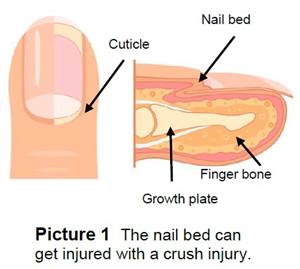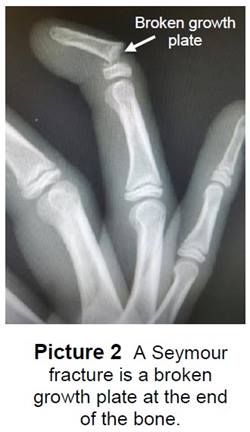Crush Injuries of the Fingertip

Crush injuries of a fingertip or the tip of a toe are common in children. They can happen when a finger is slammed in a door, a finger or toe is stepped on, or if a heavy object falls on a nail with great force. There can be an injury to the:

- Skin – a cut, scrape, blood blister, or a bruise.
- Nail – bleeding or a blood clot under the nail, a cut where the nail grows (nail bed), bleeding around the cuticle, or a cut or tear in the nail (nail laceration).
- Bone – a break (fracture) at the end of a bone where it grows (the growth plate) (Picture 1).
- Tip of the finger or toe – the tip gets cut off (partial amputation).
Most cuts, scrapes, blood blisters under the skin, and bruises heal on their own. However, if the injury looks serious, your child may need to have a doctor or health care provider check it. Take your child to an urgent care center or emergency department right away if you think that they have a broken bone or if the tip of the finger or toe is cut off.
What to Do First for a Nail Injury
A lot of times, finger and toenail crush injures cause similar damage and can be treated the same way. For most crush injuries to nails, you should:
- Wash the finger or toe with soap and water.
- Take any rings off the finger or toe before it swells.
- Put the finger or toe in cold water or wrap it with an ice pack right away. Keeping it cold will help stop the bleeding and may prevent a blood blister (hematoma) from forming under the nail.
- Wrap and press a clean cloth, paper towel, or gauze over the bleeding cut.
- Lift or raise (elevate) the finger or foot above the level of your child’s heart. This may ease the throbbing pain.
For more serious injuries to the nail, take your child to an urgent care center. Do this if there is:
- A cut or tear in the nail
- Bleeding that will not stop
- An injured nail bed
At urgent care:
- A doctor or health care provider will clean the nail and see if the nail bed is injured. Your child may need:
- A small hole put in the nail to drain the blood out from under it. This will help relieve the pressure on the nail, reduce swelling, and ease your child's pain.
- The nail removed to clean the finger and to check the injury.
- Stitches (sutures) or a special glue to treat a nailbed injury.
- A bandage to cover the finger or toe.
- After a nail is injured, even if stitched or glued in place, it may fall off in a few weeks.
- It can take up to 9 months for the nail to grow back. If the nailbed was damaged, your child's new nail may:
- Have a bend, crease, or split in it.
- Not fully stick to the skin and lift up in places.
- Not fully grow back.
Fracture of a Bone
- It is very important to get bone fractures treated right away to prevent future problems.
- Crush injuries to the fingertip can cause 2 types of bone fractures:
- Seymour Fracture - a break in the growth plate (Picture 2).
- Tuft fracture - a break in the bone closest to the tip of the finger.

- Both types of fingertip fractures are treated with a splint or cast.
- These keep the bone from moving so it will heal.
- Your child may wear the splint or cast for 2 to 4 weeks.
- Bone fractures of a toe may be treated by:
- Taping the injured toe to the one next to it.
- Wearing a rigid-soled shoe or splint that the doctor or health care provider will give you. This shoe stops the toe bone from bending.
Partial Amputation
If an injury causes part of the finger or toe to be cut off (amputated), it can be very scary. However, these wounds usually heal very well.
- Wrap the finger or toe in a clean cloth or gauze and apply firm pressure. If you still have the tip, save it. Wrap the tip in a clean cloth or gauze, put it in a plastic bag, place it on ice, and bring it with you to urgent care or the emergency department.
- Have your child raise their finger or foot above the level of their heart to help ease throbbing pain and slow down the bleeding.
- Take your child to an urgent care or emergency department.
A doctor or health care provider:
- Will clean the wound. Your child may be given pain medicine before the wound is cleaned.
- Put in special stitches if the wound can be closed. These stitches will stay in the skin until they fall out on their own.
- May stitch the piece of skin that was cut off back on if you have it. This helps protect the skin under it. The skin over the wound will often turn black and may eventually fall off.
- May refer your child to a hand or foot specialist. If a large piece of the tip was amputated, your child may need surgery.
What to Do at Home
- Do not take a bandage, splint, or cast off unless your child’s doctor or health care provider says it’s okay.
- Keep all dressings, splints, and casts clean and dry.
- At your follow-up appointment, you will get instructions on wound care, if needed.
- Until the doctor says it’s okay, your child should not:
- Take part in sports. This includes gym class.
- Lift, push, and pull most things.
- Run, jump, or play rough. Only do low energy activities.
- Expect your child to have some pain for 1 to 3 weeks. You can give them over-the-counter (OTC) pain medicines, such as acetaminophen (Tylenol®) or ibuprofen (Advil® or Motrin®). Read the label to know the right dose for your child. Do not give aspirin or products that contain aspirin.
- Your child may not be able to bend their finger or toe while it heals.
- Sometimes, your child will need to do special exercises to help the finger or toe get stronger and bend more.
When to Call the Doctor
Call your child’s doctor or health care provider if they have any of these signs of infection:
- Increase in pain
- A bad smell
- Redness, red streaks, or swelling that does not go away
- Thick, yellow, or green fluid (drainage) coming from the wound
- Fever or temperature over 101° Fahrenheit (F) or 38.6° Celsius (C
HH-I-421 • ©2016, revised 2023 • Nationwide Children's Hospital

